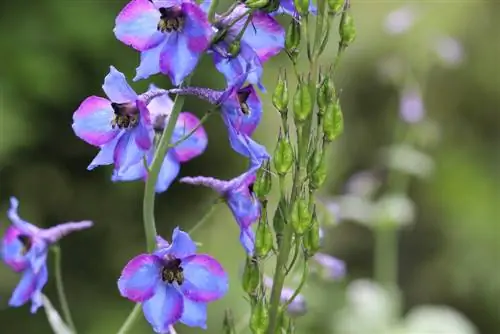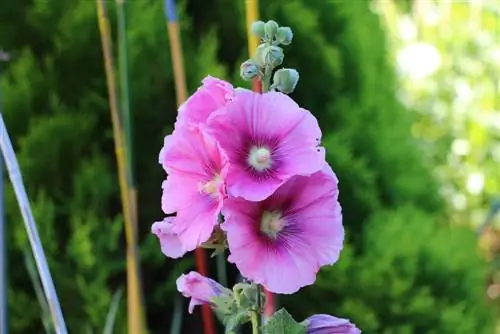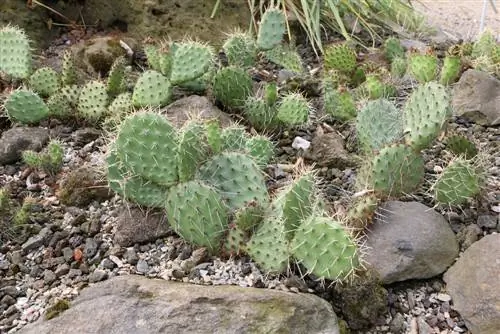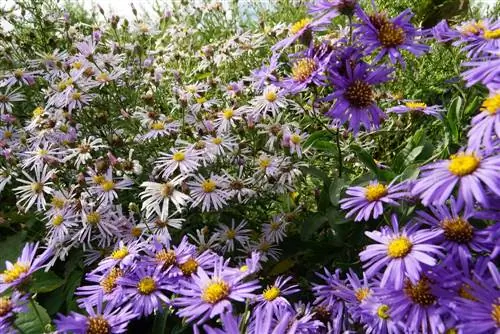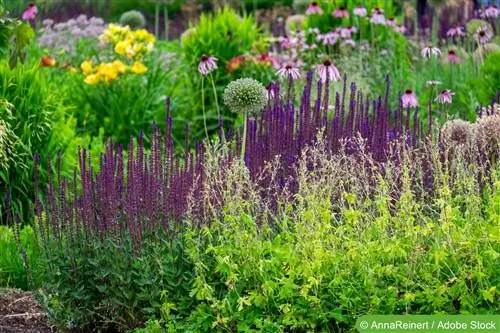- Author admin [email protected].
- Public 2023-12-17 03:39.
- Last modified 2025-01-24 12:45.
Perennials are herbaceous and perennial plants whose above-ground plant parts become woody little or not at all. In the warm months of the year, garden perennials grow and bloom in a wide range of flower colors and growth forms. They then retreat deep into the ground in winter. Since many varieties are perennial and hardy, they can thrive again in the next growing season.
From B to H
Blue Monkshood (Aconitum napellus)
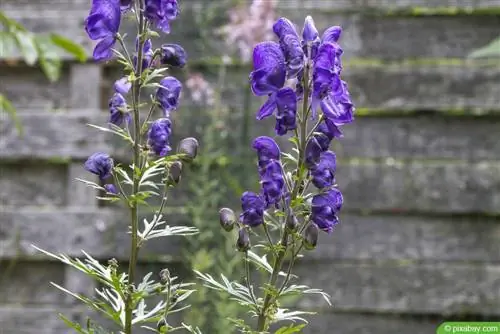
The blue monkshood has the botanical name Aconitum napellus and originally comes from the higher altitudes of the low mountain ranges in Central and Northern Europe. That's why the garden perennials are not only very hardy, but can also cope with locations in the mountains. The flowers have an unusual, helmet-like shape. However, the plant is extremely poisonous, so caution is advised when handling it.
- Impresses with violet-blue flower color
- Flowering period from July to August
- Shoots grow 1.20-1.60 m high
- Partially shaded locations are ideal
- Sandy to loamy and nutrient-rich soils
- Does not tolerate drought
Tip:
With early-blooming garden perennials, removing wilted flowers often stimulates later blooming at the end of summer.
Christmas rose (Helleborus niger)
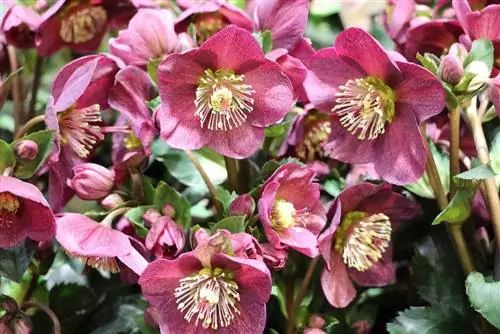
The perennial Christmas rose is called Helleborus niger in botany and is also known as the snow rose. The plant impresses in winter with its elegant and beautiful flowers. The garden perennials are very suitable as ground cover, for group planting and as underplanting. They also thrive in planters on the balcony and terrace.
- Bright white flower color
- Flowering period from January to March
- Can reach a height of between 10-30 cm
- Prefers semi-shady to shady locations
- Can cope with sandy to loamy soils
- Alkaline pH value is ideal
looseberry(Lysimachia clethroides)
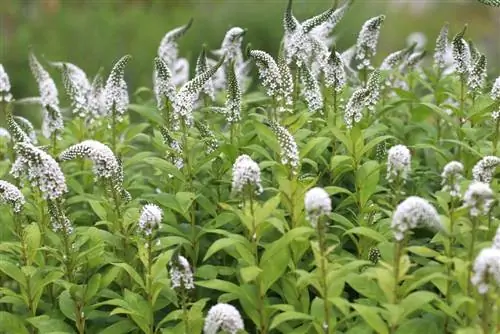
The loosestrife has the botanical name Lysimachia clethroides and belongs to the primrose family. It is also called snow loosestrife because of its flower color. The robust and easy-care garden perennials grow like clumps and upright, the leaves enchant with their beautiful autumn color.
- Forms bright white flower clusters
- Flowering time is from June to July
- Reaches heights of up to 100 cm
- Also grows strongly in width
- Prefers full sun to partially shaded locations
- Loose, nutrient-rich and fresh, moist soils are ideal
- Avoid drought at all costs
Goldenrod (Solidago virgaurea)
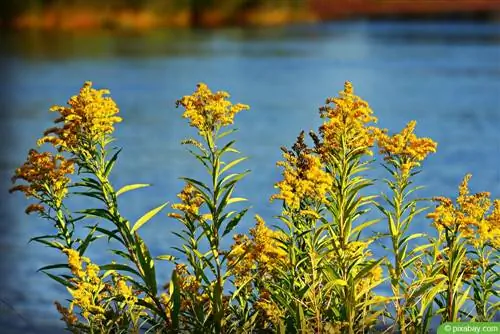
The real goldenrod has the botanical name Solidago virgaurea and is native to the local latitudes. Thanks to its grape-shaped flowers and bright color, the plant beautifies any flower bed. The relatively undemanding perennials are perennial and look good in wildflower gardens and natural garden areas. Due to their extensive growth, they serve as welcome pastures for bees and insects.
- Flowers shine in golden yellow tones
- Flowering time is from July to October
- Reaches growth heights between 30-60 cm
- Sunny to partially shaded locations are ideal
- Make sure the substrate is sandy to loamy
- Prefers moderately nutrient-rich soils
Autumn Anemone (Anemone hupehensis)

The autumn anemone has the botanical name Anemone hupehensis and, unlike most other anemone species, is hardy. The elegant perennials grow compactly and form a dense bush of leaves. The plant likes bright conditions, but does not tolerate persistent drafts or waterlogging.
- Intensely red to slightly purple flower color
- Flowering period from the end of August to October
- Can reach heights of up to 80 cm
- Prefers sunny and airy locations
- Ideal is humus-rich and loose soil
- Plant is slightly poisonous
Autumn Taster (Symphyotrichum)
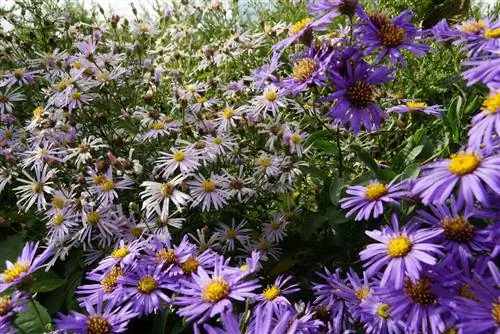
The autumn aster has the botanical name Symphyotrichum and has different flower colors depending on the variety. The perennial is not only perennial, but also blooms diligently and for a long time. Cultivated in a pot, the autumn aster can be placed on the balcony or terrace, but additional protection is required in winter.
- Flowering period from September to October
- Flowers in lavender, pink, red, violet or white
- Prefers sunny location
- Low-growing perennial, well hardy
- Growth height is between 35-60 cm
From K to P
Cockade flower (Gaillardia grandiflora)
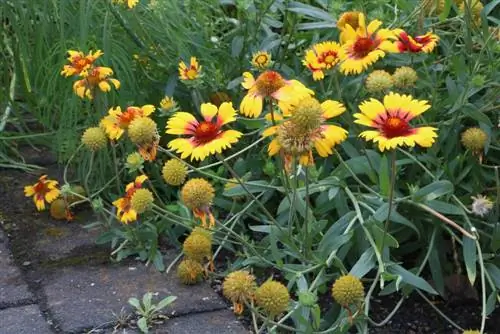
The cockade flower is called Gaillardia grandiflora in botany and enchants with large, radiating flowers. It is often planted in cottage gardens. Since the flower stalks grow upright, the plants are ideal as cut flowers for the vase. Due to the long-lasting bloom of this tireless summer flower, bees find a reliable source of food in the garden.
- Prefers sunny location
- Flowering time is from July to September
- Forms dark red flowers
- Leaves are a little hairy
- Growth height is 60-70 cm
- Needs well-drained soil
- Pay attention to nutrient-rich qualities
Lavender (Lavandula angustifolia)
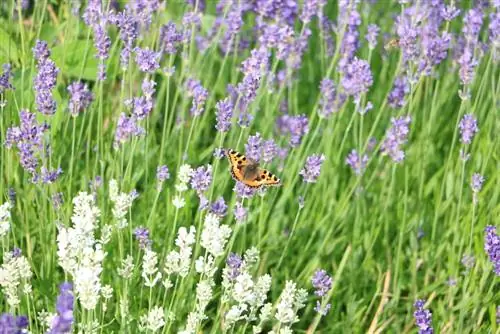
Lavender is called Lavandula angustifolia in botany and is a well-known medicinal and fragrant plant. In the garden there is an interesting combination with roses, as both plants have a strong scent. When planting, it should be noted that lavender has a very high light requirement. The garden perennials do not cope well with shady and cool conditions.
- Forms purple flower candles on long shoots
- Flowering time is from July to August
- A full sunny location is ideal
- Prefers nutrient-rich garden soil
- Covers well with drought
- Growth height depends on the variety from 35-70 cm
Note:
Beautiful lavender varieties are Grappenhall, Rosea and Siesta, which are also suitable as background plants.
Lupins (Lupinus polyphyllus)
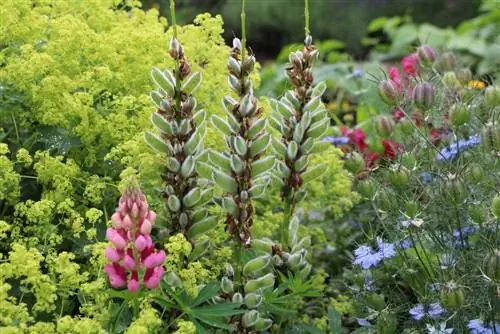
Lupins are called Lupinus polyphyllus in botany and bloom in many different colors depending on the variety. The perennials promote fertility in the soil, which is why neighboring plants benefit from their cultivation. Lupins look very nice in a colorful cottage garden together with herbs, as their large, umbrella-like leaves provide pleasant shade.
- Flowering in blue, brown, yellow, pink, red, purple or white
- Flowering time is between June and August
- Form tight and upright flower clusters
- Growth height can be up to 1.50 m
Pearl Basket (Anaphalis triplinervis)
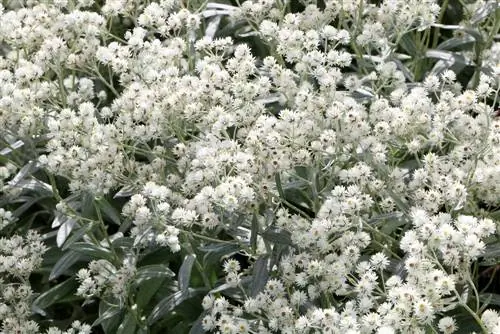
The pearl basket has the botanical name Anaphalis triplinervis and originally comes from Tibet and the Himalayas. That's why the clump-like perennials are hardy and cope well with the local locations. If the site conditions are right, the perennial pearl basket can grow extremely wide.
- White flower color, with an umbel-like shape
- Flowering period from July to October
- Needs sunny locations
- Does well with gravelly and sandy soils
- Tolerates moderately dry to fresh substrate
- Alkaline to neutral pH value is ideal
- Grows 30-40 cm high
Purple Bells (Heuchera)
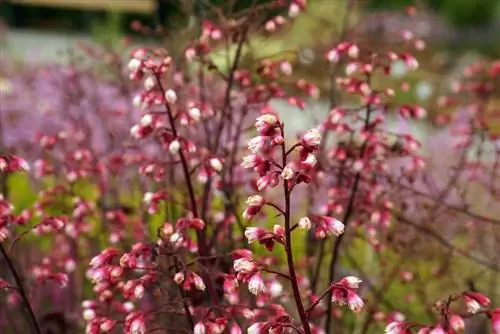
The purple bell is called Heuchera in botany and is not only a perennial, but also evergreen in regions with mild winters. Thanks to the bright leaves and the unusual leaf shape, the plant beautifies any garden area. However, their flowers are rather inconspicuous.
- Flowers in white, from May to July
- Reaches heights of 40-70 cm
- Partially shaded locations are ideal
- Leaves turn green, orange and brown
- Prefers moist and humus-rich soils
From R to T
larkspur (Delphinium elatum)

The delphinium has the botanical name Delphinium elatum and is well suited for a cottage garden. Its growth is upright like a candle, which is why the plant is suitable as a cut flower. It is one of the garden perennials that, depending on the location conditions and the variety, can reach an immense height of up to two meters.
- Prefers sunny location
- Is extremely frost hardy
- Humid garden soil is ideal
- Flowers in blue, red or white colors
- Flowering time is from June to September
Coneflower (Echinacea purpurea)
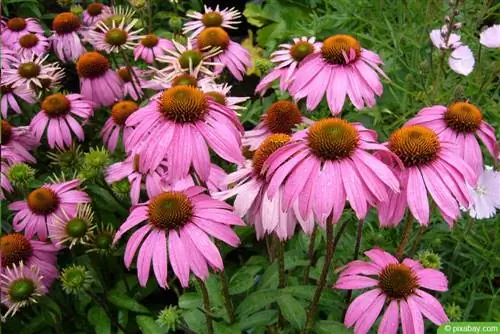
The coneflower is botanically called Echinacea purpurea and requires a lot of care in order to thrive. As perennials, the plants beautify any garden thanks to their intensely bright flowers. It is also possible to keep it in a bucket on the balcony or terrace. Due to its straight growth, the coneflower is also suitable as a cut flower for decoration.
- Red or purple flowers are widespread
- Varieties also in yellow, purple, orange, pink or white
- Flowering time is from July to September
- Growth height can be up to 2 m
- Prefers sunny location conditions
- Humid garden soil is ideal
bleeding heart (Dicentra spectabilis)
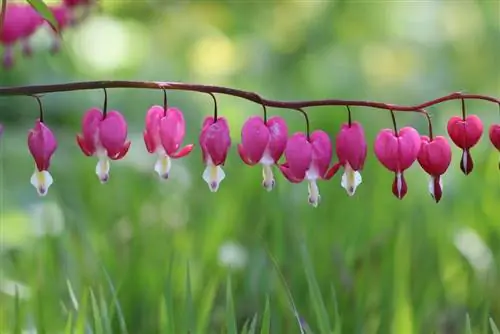
The bleeding heart has the botanical name Dicentra spectabilis and belongs to the poppy family. The special name comes from the unusual flowers, which resemble a small heart in shape. In contrast, the foliage of the perennial garden perennial is delicately feathered and therefore appears rather inconspicuous. The plant cannot cope with strong sun and extremely hot site conditions, so it thrives well in light shade between significantly taller perennials and under trees.
- Pink and strikingly shaped flowers
- Reaches heights of 50-90 cm
- Flowering time is from May to August
- Prefers partially shaded locations
- Human rich and permeable soils are ideal
- Does not tolerate long-term drought
Turkish poppy (Papaver orientale)
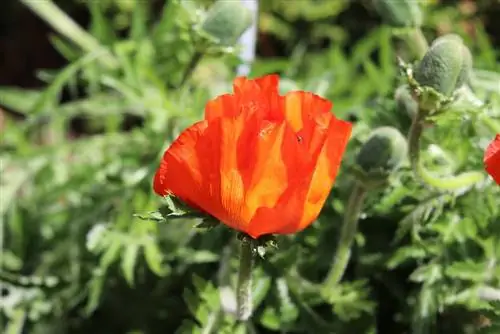
The Turkish poppy has the botanical name Papaver orientale and is also known as the garden poppy. The plant originally comes from Turkey and is also found in Iran and the Caucasus. There, the perennials often grow on calcareous slopes at high altitudes, which is why mountainous locations are also suitable for cultivation.
- Produces bright red flowers
- Flowering period from May to June
- Needs sunny and warm locations
- Sandy to loamy substrate is ideal
- Can cope with dry soils
- Can reach heights of up to 30 cm
- Poisonous plant, caution with children

